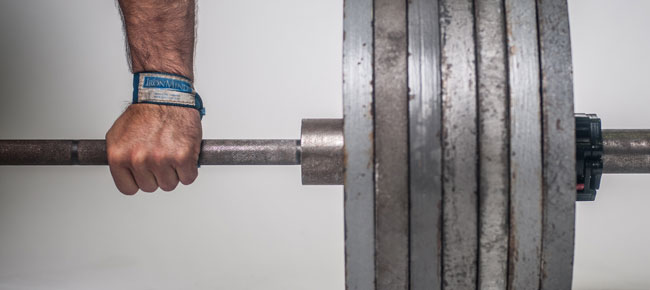
Lifting straps are fantastic. Like belts they’re a tool that used properly will allow you to lift more weight and get more out of your training than you could otherwise. Used improperly – well not so much.
Something you’ll hear often from people who don’t even lift (or very much) is that straps will make you weaker in the long run or that you’re only as strong as your weakest link, and straps will cause that to be your grip. While it’s true that you can only lift what you can hold on to, there are a lot of qualifiers to that statement so let’s look at it like this.
Straps are to barbells as belts are to pulling heavy as tacky is to stones. All of those pieces of equipment allow you to lift heavier weight than you would be able to without them. But, how does that make you stronger?
If you can only deadlift 5 reps with 400lbs before your grip goes out, but are able to deadlift 10 reps with straps you are able to place your entire posterior chain under double the stress than you would be able to otherwise.
If you can only lift a 220lb Atlas stone without tacky, but you can lift a 270lb stone with tacky you are able to add 50lbs to the amount of stress your arms, back, glutes and entire body for that matter is placed under. More weight makes you stronger.
In both of these cases, provided you’re doing some other specific exercises to improve your grip strength you will come back to the lighter weights with an overall stronger body.
If you still don’t understand how straps can make you stronger, not weaker, I have lost interest in trying to convince you.
Here is a good technique for actually using the straps that should ensure that it never slips off your implement.


David,
Thank you for this video. Excellent technique. Will give this a shot, I am sure I will benefit greatly from it.
Also, congratulations on placing second in the 2014 winter strongman assault. I knew you would place well on the events that primarily depended on posterior chain strength.
As for the log press, do you think a higher squat (I believe your max is around 400 if I remember correctly) would have helped you generate more dipping power and consequently overcome the lack of shoulder strength?
By the way, loved your intensity there. There is nothing like a serial killer stare when lifiting heavy stuff. 🙂
As for the value of quick steps on the final event, this was one of Mariusz Pudzianowski’s strong points. Bill Kazmaier stated in the 30 Years of Pain documentary that he believes he was stronger than Mariusz, but “boy, could he run”.
Ted
Ok; now I’m confused. I’ve spent quite a bit of today reading articles on this site and it’s all very interesting. But I’m getting that your main intention is that people stop a set when it starts to get hard – i.e. a few reps before failure.
But in this article you are saying that anything that helps you lift more weight and put more stress on the muscles will give you better results.
So which is it? Stop a few reps before failure or use the maximum weight you can and push to the limit?
Would be really interesting to have some clarification on the matter. Thanks. (Sorry this comment got posted on the wrong article initially; feel free to delete it from there – thanks).
David,
These things are not mutually exclusive. I’ve found that stopping sets before elements of effort (not necessarily before it gets hard, sometimes every rep is hard) is the best way to make long term progress.
Completely unrelated to that, overloading a movement (deadlift) by taking out the weak link (the hands) allows you greater stress in the other links. Of course your hands aren’t going to get stronger, but you can address that in other more specific ways.
Does that make sense how these things are not exclusive?
Yes, thank you, I do understand that. It’s just that the tone of the article seemed to suggest you were advocating pushing to the limit. I must have just misunderstood.
Though I’d be very interested to know how you define ‘elements of effort’. Can you explain this, or do you have an article that describes it?
Also do you always advocate training this way, or do you sometimes push all the way to see what you can do? And is it beneficial to do this occasionally anyway? Thanks again.
Elements of effort are specifically speed, tension, breathing, alignment, failure, pain, damage not necessarily in that order. All are signs that movement quality is decreasing. The vast majority of my training is in this method, or primarily eustressful. You can read a bit more about that idea here http://www.dellanave.com/more-work-less-time-smarter-conditioning/ There is always a time for pushing to the limit, it just is rare.